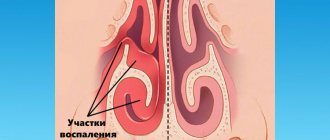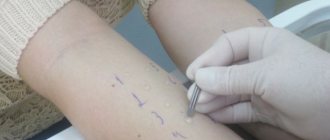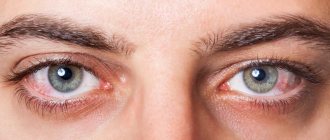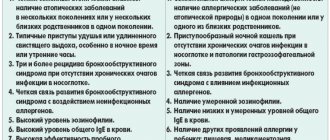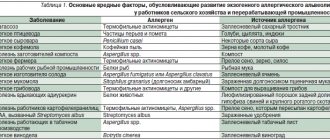Everyone is familiar with the unpleasant condition of a cold, when the nose is constantly stuffy. According to statistics, an ordinary person gets a runny nose more than 100 times from birth to old age. It is interesting that of all the diseases in Russia, every third is a respiratory disease, and every seventh is a cold (rhinitis, sinusitis, etc.).
Runny nose (rhinitis) is a common disease of the upper respiratory tract, transmitted by airborne droplets. One of the main factors in the development of rhinitis is hypothermia, it reduces the body's defenses, provokes the proliferation of microbes in the nose and nasopharynx and leads to nasal congestion.
Another factor related to rhinitis is a decrease in immunity after suffering from chronic diseases.
1 Diagnostics of rhinitis in MedicCity
2 Endoscopy of the nasal cavity in MedicCity
3 Diagnostics of rhinitis in MedicCity
Clinical picture of rhinitis
Rhinitis can be part of an acute respiratory infection and the beginning of an allergic reaction.
The disease begins with a deterioration in the general condition of the body, headache, weakened sense of smell, and it becomes difficult for a person to breathe through the nose. The nose may also be stuffy, pathogenic microflora begins to develop in it, and first clear, then green and brown nasal discharge appears.
If you have a fever and a stuffy nose, it could be rhinitis!
Symptoms of rhinitis:
- severely stuffy nose;
- nasal discharge (watery, mucous or mucopurulent);
- mucus running down the back of the throat;
- sleep disturbance;
- snore;
- headache.
A lot can be said about rhinitis, but the primary task of treating chronic rhinitis is to eliminate the causes that support the chronic inflammatory process of the nasal mucosa.
Why does my nose get stuffy? Causes:
- chronic inflammation of the paranasal sinuses;
- deviated nasal septum;
- anomalies in the structure of the nasal concha;
- adenoid vegetations, etc.
In such cases, normal air circulation is disrupted, pathological discharge flows into the nasal cavity, irritates the mucous membrane and maintains a chronic runny nose.
Prevention
Competent prevention allows you to avoid severe illness of any disease. In many cases, thanks to such measures, a person does not get sick at all, this is:
- competent and timely treatment of any ENT pathologies;
- exclusion of allergens;
- elimination of congenital anomalies through surgical correction;
- the use of moisturizers and products with sea tar;
- healthy lifestyle;
- rejection of bad habits;
- taking medications to strengthen the body and improve immunity.
How to cure chronic runny nose? After making a diagnosis, you should buy a modern, high-quality remedy for chronic runny nose, which was prescribed by a specialist. Affordable drugs for the treatment of all forms of the disease are available in a wide range in the Stolichka social pharmacies network.
Acute rhinitis
Acute rhinitis is one of the most common diseases in childhood. Every mother is familiar with its symptoms: the child’s nose is stuffy, runny nose, etc.
Acute rhinitis has an infectious form, caused by viruses or bacteria. The disease can manifest itself as a separate disease of a viral or bacterial nature or be a component of infectious diseases such as influenza, ARVI, scarlet fever, meningitis, diphtheria, etc.
Provoking factors for acute rhinitis are hypothermia, polluted air, decreased human immunity, allergies, adenoids, and hypertrophic rhinitis. Therefore, if the nose is constantly stuffy, the child clearly has weak immunity, and it needs to be improved!
Symptoms of acute rhinitis:
The disease occurs in 3 stages:
- discomfort in the nose, itching, sneezing, tears, headache, malaise, fever (within 1-2 days);
- the nose is stuffy, it becomes difficult for the patient to breathe, hoarse voice, watery discharge from the nose, decreased sense of smell;
- The nasal discharge becomes thick and purulent, and the patient is bothered by severe nasal congestion.
1 Consultation with an otolaryngologist in MedicCity
2 Consultation with an otolaryngologist in MedicCity
3 Consultation with an otolaryngologist in MedicCity
Postoperative recovery
An important stage in the surgical treatment of inferior turbinate obstruction is postoperative recovery. Minimally invasive methods of removing the affected layer of the mucous membrane of the nasal passages significantly facilitate recovery after surgery and minimize the recovery time.
In the first hours after surgery, the patient is under the supervision of an ENT doctor. During this period, reactive swelling of the nasal mucosa may develop, which is not considered a complication. If necessary, medications are used to facilitate and accelerate postoperative recovery.
To successfully complete rehabilitation, the patient must comply with all instructions and appointments:
- diet excluding spicy, hot foods, carbonated drinks;
- prohibition of physical activity, thermal procedures, hypothermia;
- rinsing the nose with recommended solutions, decoctions, using combined vasoconstrictor sprays (do not blow your nose);
- antibacterial therapy.
Typically, recovery after rhinosurgery occurs on an outpatient basis. In some difficult cases, the patient may be monitored for a day in the hospital. The period of healing and restoration of nasal breathing functions ranges from 7-10 days to 3 weeks.
Chronic rhinitis
Chronic rhinitis is a long-term, chronic inflammation of the nasal mucosa, which appears as a result of the negative influence of microbes, as well as some environmental factors (dust, air pollution) on the nasal mucosa.
Types of chronic rhinitis
- allergic (seasonal, allergies to plants and products);
- infectious (occurred as a result of infectious diseases);
- non-allergic, non-infectious rhinitis (medicinal rhinitis, hormonal rhinitis, rhinitis of the elderly).
Atrophic rhinitis
Simple atrophic rhinitis
This form of chronic rhinitis is based not on an inflammatory process, but on a dystrophic process, affecting mainly the mucous membrane. It may be a particular manifestation of a systemic disease, in which trophic disorders (atrophy) spread to the pharynx, larynx and other organs and systems. This is the so-called primary (genuine) atrophic rhinitis, the extreme degree of which is a fetid runny nose (ozena).
Secondary atrophic rhinitis
Secondary atrophic rhinitis is a consequence of exposure to various unfavorable environmental factors: hot, dry climate, dust and gas pollution in the atmosphere of industrial production (flour milling, woodworking, cement, silicate, chemical, etc.). Various injuries also play a role in the development of atrophic rhinitis - domestic, gunshot and surgical, causing damage to the tissues and blood supply of the nasal cavity.
Morphological changes
Morphological changes in simple atrophic rhinitis are most pronounced in the epithelial layer of the mucous membrane. The number of mucous goblet cells decreases, the ciliated epithelium loses cilia and degrades. The viscosity and pH of nasal secretions change, which leads to disruption of the functional activity of the ciliated epithelium.
Clinic and symptoms of atrophic rhinitis
Patients suffering from atrophic rhinitis are characterized by complaints of a feeling of dryness and itching in the nose, constant drying of yellowish-greenish crusts, the removal of which is accompanied by injury to the mucous membrane. In cases where the process affects the olfactory zone, hypo- and anosmia develops. In some cases, patients note an unpleasant odor that is not detected by others (kakosmiasubjectiva).
Treatment of atrophic rhinitis
When treating atrophic rhinitis, it is necessary, as with other forms of rhinitis, to eliminate or reduce the impact of harmful environmental factors. A course of treatment with ointments and iodine-glycerin is prescribed locally. In the morning and evening, the patient should inject Vojacek's diahilum ointment into the nose on a cotton swab for 10 minutes. Twice a week, the doctor or the patient himself lubricates the nasal mucosa with a solution of iodine-glycerin. This treatment is carried out for 2 months and is repeated 3 times a year. It is popular to insert cotton swabs into the nose with rosehip or sea buckthorn oil in olive or peach oil in a ratio of 1:3 - 1:4 or with the addition of an oil solution of vit. A (no more than 50,000 IU). Oral intake of Vit is also appropriate. And, and a complex of multivitamins with microelements (for example, Vitrum).
In the treatment of atrophic rhinitis, alkaline and oil inhalations through the nose are widely used. During spa treatment, irrigation of the nasal cavity and inhalation of mineral waters from local sources are useful. The most effective are inhalations and irrigation of the mucous membranes of the upper respiratory tract with 2 - 3% solutions of sea salt, as well as sea bathing. This is due to the fact that magnesium ions contained in sea water have a beneficial effect on the mucous membrane.
Allergic rhinitis
Allergic rhinitis is an inflammation of the mucous membranes of the nose, which is based on an allergic reaction of the body to any allergen.
Possible allergens:
- household or book dust;
- dust mite;
- insect bites;
- plants;
- Food;
- medications;
- molds and yeasts.
You can read more detailed information about allergic rhinitis here.
Preparation for surgery, tests
Patients who are prescribed vasotomy (vaporization) must undergo preoperative preparation. Its main goals are to clarify the diagnosis, assess the general state of health, identify possible contraindications, and select optimal anesthesia. The preparation program for surgery includes, in particular, the following components:
- consultations with a therapist, dentist, anesthesiologist;
- sanitation of the oral cavity;
- X-ray or CT scan of the sinuses, chest organs;
- performing rhinoscopy;
- taking and deciphering an electrocardiogram of the heart;
- laboratory tests (urine and blood tests).
Clinical blood tests include: general analysis with leukocyte formula and biochemical analysis, coagulation test, group, rhesus. Tests can be taken at your place of residence and the results can be provided to the attending ENT doctor at our clinic (there are limitations on the statute of limitations).
The scope (list) of tests and other types of research depends on the general condition of the person who contacts the clinic for help, his age, and the presence of concomitant diseases (contraindications). An individual approach is used for each patient in preparation for surgery.
How does the operation take place?
The procedure for surgical treatment of obstruction of the lower nasal passages (rhinitis, deviated septum) is standard. The operating ENT doctor may make some adjustments based on the results of the preoperative examination (anatomy, age, nature of the pathology, test data).
On the day of surgery, the patient should refrain from eating, not drinking drinks, and the day before not consuming foods that affect blood clotting. The attending physician at our clinic will provide the necessary detailed instructions.
As a rule, when treating rhinitis, surgery is performed under local anesthesia, less often under general anesthesia. Powerful anesthetics are used, and there is virtually no pain. Considering the short duration of rhinosurgical intervention and the high qualifications of the operating doctor, patients tolerate the operation well.
During the operation, the patient is positioned comfortably in a reclining or lying position. The eyes are protected with special glasses. Breathing is done through the mouth. The surface of the skin around the nose is treated with a disinfectant solution. Surgical procedures begin after the onset of anesthesia.
The specific scheme of the operation depends on the chosen method of reducing the mucous membrane of the nasal turbinates.
Vasomotor rhinitis
Vasomotor rhinitis refers to non-allergic, non-infectious rhinitis. There are medicinal, hormonal, reflex and idiopathic vasomotor rhinitis. It is characterized by impaired nasal breathing, nasal congestion and narrowing of the nasal cavity as a result of swelling and swelling of soft tissues.
Reasons for the development of vasomotor rhinitis:
- low air temperature;
- wet air;
- eating too hot or spicy food;
- frequent consumption of alcoholic beverages;
- experiencing emotional stress;
- inhalation of tobacco smoke;
- smog, air pollution;
- strong odors;
- hormonal changes in the body;
- long-term use of vasoconstrictor drugs;
- use of contraceptives or medications that lower blood pressure;
- thyroid disease, etc.
Clinical signs and symptoms of vasomotor rhinitis
The main symptoms of this form of rhinitis can be considered difficulty in nasal breathing and watery discharge from the nose. Sneezing attacks are less common.
Most often, vasomotor rhinitis is confused with atypical forms of allergic rhinitis. Therefore, a thorough examination is necessary.
1 Endoscopy of the nasal cavity in MedicCity
2 Endoscopy of the nasal cavity in MedicCity
3 Endoscopy of the nasal cavity in MedicCity
Particular runny nose. What is vasomotor rhinitis and how to get rid of it?
What is vasomotor rhinitis and how to get rid of it? What consequences can result from improper treatment of vasomotor rhinitis? These and other questions are answered by the leading specialist of the National Medical and Surgical Center. N. I. Pirogova, candidate of medical sciences, associate professor, otorhinolaryngologist Oleg Aleksandrovich Golubovsky.
— Oleg Alexandrovich, what is vasomotor rhinitis? What is its feature?
— Let's start with the fact that a runny nose can be acute and chronic. Vasomotor rhinitis is a variant of chronic runny nose. If an acute runny nose is not treated adequately, it can become chronic. First, nasal breathing becomes difficult, then mucous discharge appears, which can discharge from the nose to the outside or flow down the back wall of the throat, which happens most often.
In terms of symptoms and complaints, vasomotor rhinitis is very similar to allergic rhinitis. Allergic rhinitis is also accompanied by swelling of the nasal mucosa, but this is a seasonal disease, that is, it occurs during the flowering period of plants, or if there is an allergy to house dust, library dust, animal hair, etc.
- Let's talk about the causes of vasomotor rhinitis. Why is it developing?
— There are two main reasons. The first is a consequence of untreated or undertreated acute rhinitis. And in second place is deformation of the nasal septum. If there is an arched curvature of the nasal septum to the left or right, a complex curvature of the so-called S-shape or a single ridge, then the mucous membrane is irritated by the incorrectly moving air flow. The air entering through the nose during normal breathing receives some turbulence. Thanks to this, the air is moistened, warmed, and dust from it settles on the mucous membrane of the nasal cavity. That is, the air enters the lower respiratory tract already warmed, more or less cleared of dust and humidified. And when there is a mechanical reason (deformation of the nasal septum), the air flow changes, thereby irritating the mucous membrane, the nasal turbinates swell, and a picture of vasomotor rhinitis gradually develops.
Read more about a deviated nasal septum in our article: Deviated nasal septum: leave it or fix it?
— What are the symptoms of vasomotor rhinitis?
- First of all, this is difficulty in nasal breathing and mucous secretions that flow down the back wall of the pharynx, as a result of which a picture of pharyngitis develops (inflammation of the back wall of the pharynx). A person complains of a feeling of a lump in the throat, a feeling of viscous mucus that is difficult to cough up. As the patients themselves say when they come for consultations, “a mucus factory”, mucus flows in a stream. These are all signs of vasomotor rhinitis. The sense of smell is also often impaired. Due to swelling of the mucous membrane, the olfactory zone suffers, and the person ceases to perceive odors - either all or selectively.
— How to distinguish vasomotor rhinitis from a common runny nose?
— There is no concept of a “common runny nose.” There is acute and chronic runny nose. If we say that it began suddenly and lasts, let's say, no more than a month, then this may be a condition that is considered an acute runny nose. And there is a runny nose, which becomes chronic.
Chronic rhinitis can be vasomotor and hypertrophic. Stepping back a little, I’ll explain. Each half of the nose has three conchae: inferior, middle and superior. The top one is so small that it is not visible. We see first of all the inferior nasal concha and the middle one (it is smaller in size, but visible). It is the inferior nasal concha that swells, making nasal breathing difficult. Why do nasal breathing difficulties occur? And what is the inferior nasal concha anatomically? It has a small bone base, which is covered with tissue rich in blood vessels. With the slightest inflammatory process (chronic or acute), the vessels in this area dilate, blood flow increases, and the shell swells sharply, increasing in size several times, filling the entire common nasal passage. If this is vasomotor rhinitis, then after instilling any vasoconstrictor drops, the concha contracts, the result is a short-term improvement in nasal breathing. If this is already hypertrophic rhinitis, then the concha does not shrink, remains as large and the nose breathes just as poorly.
— How is the diagnosis of “vasomotor rhinitis” made? What examinations are carried out to identify this pathology?
— First, we base it on the patient’s complaints, which we discussed above. The second is an examination of the nasal cavity. We see swollen inferior turbinates. Usually, irrigation or application (application) of a solution of adrenaline (or xylometazoline-based preparations) is carried out on the mucous membrane. If the shell has shrunk, then the condition corresponds to vasomotor rhinitis. If it has not decreased, it is already hypertrophic rhinitis. There are practically no other diagnostic options.
— Tell us about the methods of treating vasomotor rhinitis in children and adults
“The treatment of this pathology in children and adults is not much different. As a rule, this is, firstly, rinsing the nose with sea water. If it is not possible to irrigate with sea water, then you can use saline solution. What do these solutions do? They wash the mucous membrane, remove excess mucus and force the goblet cells to empty. These are cells that are part of the mucous membrane and produce mucus. They empty themselves, and due to this the mucous membrane contracts somewhat. Nasal breathing improves to a small extent.
After irrigation with sea water, we always recommend using certain hormonal drugs from the group of glucocorticosteroids. They can be used from childhood (from about two years old). Vasoconstrictor drops cause a sharp constriction of blood vessels, and the nose begins to breathe almost immediately. In contrast, a hormonal drug acts slowly, but gives a lasting effect. We do not recommend using vasoconstrictor drops for more than 7 days. At the first stage, this can be done, but if time passes, say, a week is approaching, then in any case the person needs to refuse these drops, replacing them with hormonal drugs.
In some cases, doctors resort to injecting the inferior turbinates with glucocorticosteroids. An injection is made, the tissue is saturated with a medicinal substance, and gradually, during the course of treatment, the shell contracts.
Physical therapy may also be indicated. But this is all conservative treatment. If it is ineffective, we suggest surgical treatment.
— What about traditional medicine? For example, the question is sometimes asked whether herbal treatment for vasomotor rhinitis is effective. What could you say about this?
— You can rinse your nose with a decoction of chamomile, for example, but it is not a panacea. In some cases, you can use some plant-based preparations containing, for example, eucalyptus oil, fir oil. But any oil drops are used for no more than 10–14 days, since they negatively affect the mucous membrane.
— In what cases is surgical treatment necessary? What operations are performed for vasomotor rhinitis and how are they performed?
— Surgical treatment is indicated in one hundred percent of cases when the conservative treatment we discussed is ineffective. How is surgery performed for vasomotor rhinitis?
There are quite a few types of surgical treatment. Firstly, laser destruction is carried out. A special surgical laser pulse strikes certain points of the inferior nasal concha, as a result of which the soft tissue is partially evaporated. As a result of this, the shell contracts.
Another method is ultrasonic disintegration using a special apparatus (it is produced by our industry). The electrode is inserted into the thickness of the inferior nasal concha; against the background of ultrasound, the concha is partially coagulated and partially evaporated.
The third is radio wave surgery. What is now popular and widely used. This is the impact on the sink with a radio knife (non-contact method). Coagulation occurs to some extent and plus evaporation of the soft tissues of the inferior turbinate.
And the fourth type of operation is the so-called lateropexy with vasotomy. How is this operation done? A kind of breaking of the bony base of the concha is performed and it is moved to a lateral position, i.e., from the plane of the nasal septum to the side wall of the nasal cavity. Then a vasotomy is performed: the soft tissue of the inferior turbinate is instrumentally peeled off from the bone base, which leads to a local disruption of the blood supply. Vasotomy is performed to reduce blood flow to the inferior turbinate.
— What could be the consequences if you ignore the symptoms of vasomotor rhinitis or try to treat it yourself?
— With poor nasal breathing, the brain lacks oxygen, which can lead to chronic brain hypoxia. This time. The person begins to snore at night. Because of this, his sleep suffers, and, in addition, snoring can disturb others. That's two. A person's sense of smell suffers. He ceases to perceive smells normally, which will also depress him. That's three.
In addition, with prolonged use of vasoconstrictor drops, the time of their effect is shortened, patients are forced to drip drops more often and increase the dosage. Over time, this leads to atrophy of the nasal mucosa, and the formation of perforation (defect) of the nasal septum is possible. This often manifests itself in the form of characteristic noisy or wheezing breathing through the nose. As perforation increases, deformation of the external nose in the form of subsidence of the nasal dorsum is possible.
What else could it be? Against the background of vasomotor rhinitis, sinusitis, such as sinusitis, frontal sinusitis, and ethmoiditis, can develop with any inflammation.
Read material on the topic:
How to treat sinusitis at home? What will an MRI of the sinuses show?
— Is it possible to get rid of this disease once and for all, or can it periodically bother the patient throughout his life?
— If a person has a deviated nasal septum, the symptoms of vasomotor rhinitis will persist. In such cases, we always tell the patient that it is necessary to undergo septoplasty, i.e. correction of the nasal septum. Then there will be an effect.
If the nasal septum is smooth, then courses of hormonal therapy and irrigation of the nasal mucosa with sea water can be repeated every three to six months. And there comes a time when a person has all the symptoms of vasomotor rhinitis.
If, nevertheless, there are relapses after a short period of time (a period with normal nasal breathing of no more than one month), or the conservative treatment carried out is simply ineffective, then the question of surgery is raised. After surgery, a lasting effect occurs, nasal breathing is restored. But if a person develops an acute runny nose after surgery, and he again did not treat it or treated it incorrectly, then the picture of vasomotor rhinitis may again appear. There are times when it is necessary to operate again.
It is extremely rare that postoperative complications may develop in the form of adhesions in the nasal cavity or perforation of the nasal septum. But this is a very small percentage.
— Oleg Alexandrovich, how to prevent the development of vasomotor rhinitis? Tell us about prevention
— If there is an acute runny nose, it is advisable to contact an ENT doctor so that he can examine the patient and prescribe treatment. In some cases, some drugs are used, in others, others. Treatment should be carried out comprehensively and always under the supervision of an ENT doctor. I repeat that vasoconstrictor drugs can be used for no more than seven days. If the cause of vasomotor rhinitis is a crooked nasal septum, then septoplasty is necessary.
Interviewed by Marina Volovik
The editors recommend:
Autumn ailments: allergic rhinitis in children Can’t breathe! How to treat a runny nose in children? What is ARVI?
For reference:
Golubovsky Oleg Alexandrovich
In 1986 he graduated with honors from the North Ossetian State Medical Institute, in 1988 – clinical residency in otorhinolaryngology. Currently, he is an otolaryngologist in the department of otorhinolaryngology of the National Medical and Surgical Center named after. N.I. Pirogova (Moscow), Associate Professor of the Department of the Institute of Advanced Studies of the National Medical Center, Candidate of Medical Sciences, doctor of the highest qualification category. Reception is conducted at the following addresses: Moscow, st. Nizhnyaya Pervomaiskaya, 65; at the “Clinic Expert” Vladikavkaz, Vladikavkaz, st. Barbashova, 64a (once every two months (by appointment)).
Hypertrophic rhinitis
The disease hypertrophic rhinitis is characterized by an increase in the mucous membrane of the nasal turbinates, which entails difficulty breathing due to nasal congestion.
Factors contributing to the disease:
- hypothermia of the body;
- long-term use of vasoconstrictor drugs;
- infections in the nasopharynx;
- contaminated air;
- alcohol;
- smoking;
- presence of allergies.
Hypertrophic rhinitis can occur due to the following diseases:
- diseases of the endocrine system;
- diseases of the heart and blood vessels;
- congenital or acquired curvature of the nasal septum;
- pathology of the neuro-reflex function of the nose;
- untreated catarrhal, vasomotor and chronic rhinitis.
How does the disease manifest?
Hypertrophic rhinitis is characterized by a stuffy nose and difficulty breathing, and vasoconstrictor drops do not eliminate these symptoms. With hypertrophic rhinitis, the following symptoms appear:
- the nose does not breathe;
- mucous and purulent discharge from the nose;
- recurrent headaches;
- dry mouth and nasopharynx;
- disturbances of taste and smell.
Causes and classification of rhinitis
Risk factors for developing the disease include a decrease in general immunity, unfavorable living conditions (strong or prolonged exposure to irritants) and individual intolerance to certain allergens.
According to the course of the disease, they are distinguished:
- acute rhinitis (occurs after the initial exposure to a pathogen or allergen and lasts up to 3 days);
- chronic rhinitis (usually develops as a complication of an acute process and persists for several weeks and even years).
Depending on the cause, there are:
- allergic rhinitis, which develops when the nasal mucosa comes into contact with an allergen - pets, pollen, house dust, mite or yeast allergens. Symptoms can be seasonal (for example, with aggravation in spring, during the flowering period of plants) or year-round;
- non-allergic rhinitis is caused by hypothermia or sudden changes in humidity, viral infections, strong irritants (strong odors, smoke, dust), certain medications (including vasoconstrictor drops), food allergies, disruption of certain organs (thyroid diseases, gastroesophageal reflux), and rhinitis of pregnant women and senile rhinitis are also distinguished;
- Vasomotor rhinitis is not associated with either allergens or pathogens, and develops with hyperactivity and dilation of the blood vessels of the nasal cavity wall. The cause is considered to be an imbalance of the autonomic nervous system, which cannot cope with the function of “inhibiting” the reaction of the nasal mucosa to environmental conditions. The causes may be stress, physical activity, endocrine diseases, as well as hereditary predisposition. In a third of such patients, the disorder is chronic, and in half it manifests itself to a moderate or severe degree.
The causes of rhinitis in children are considered to be imperfect immunity and unfavorable environmental conditions. In addition, this disease in children can be caused by a deviated nasal septum, diathesis, adenoids and polyps, foreign bodies in the nose, sinuses, and long-term use of vasoconstrictor drops.
Chronic catarrhal rhinitis
Chronic catarrhal rhinitis is persistent inflammation in the epithelial tissues of the nose, which does not lead to changes in the structure of the nose.
Typically, chronic catarrhal rhinitis appears as a result of an untreated form of acute rhinitis or its advanced form. In the case of an advanced form, pathogenic organisms multiply in the nasal mucosa, causing catarrhal inflammation.
Symptoms of the disease:
- runny nose that appears in autumn and winter;
- mucous or purulent discharge;
- lack of sense of smell (no nose breathing at all);
- headache.
Diagnostics
During an examination, an ENT doctor may detect boils, cracks and eczema in the nasal cavity. During rhinoscopy, mucus in the nasal cavity in the form of a mesh can be noted.
Diagnosis of rhinitis at the Clinical Hospital on Yauza
In order to prescribe effective treatment, it is necessary to determine the form of rhinitis.
To do this, our specialists carry out comprehensive diagnostics, namely:
- visual inspection
- microbiological examination of nasal secretions
- rhinoscopy
- cytological examination of nasal secretions
- endoscopic examination of the nasal cavity
Based on the diagnostic results, an examination may be prescribed by related specialists - an allergist, endocrinologist, etc.
Treatment of rhinitis
What to do when your nose is stuffy?
Everyone understands what inconvenience a stuffy nose can cause. Treatment must be comprehensive.
The treatment regimen for rhinitis includes the following measures:
- elimination of possible endo- and exogenous factors that cause and maintain rhinitis;
- drug therapy for each form of rhinitis;
- surgical intervention according to indications (for example, for a deviated nasal septum);
- physiotherapy and climate therapy.
Conservative treatment of rhinitis
Conservative therapy includes the following methods:
- Ultrasound and injection inhalation of medicinal substances into the nasal cavity.
- Rinsing the nose and nasopharynx with medicinal substances using a suction aspirator.
- Photodynamic therapy is a unique method of treating rhinitis, based on the use of a photosensitive drug, photoditazine, in the form of a gel, followed by its activation by laser irradiation of the nasal cavity. The drug accumulates in “sick” cells; after laser irradiation, a large amount of oxygen is released, which causes the death of damaged cells and has a powerful antiseptic and anti-inflammatory effect. The volume of the nasal turbinates decreases, nasal breathing improves, and discharge stops. As a result of therapy, you will finally be able to get rid of nasal congestion. The procedure is absolutely painless and takes 1.5-2 hours. Performance is not affected. A course usually requires 2-3 procedures.
- Applications of medications to the nasal mucosa.
1 Sinus Pari inhaler
2 Rinsing the nose and nasopharynx
3 Photodynamic therapy in MedicCity
Surgical treatment of rhinitis
Sometimes it is impossible to do without surgical treatment of rhinitis. In this case, the choice of rational surgical tactics is based on the degree of hypertrophy of the nasal turbinates and impaired nasal breathing. All methods used in our clinic are as gentle as possible.
Surgical treatment of rhinitis includes the following procedures:
- Radio wave coagulation of the inferior turbinates is the most gentle method of treating vasomotor and hypertrophic rhinitis. After anesthesia of the mucous membrane, an electrode with 2 thin needles is inserted into the nasal concha. Under the influence of radio waves, the nasal concha shrinks literally “before our eyes”; nasal breathing improves already at the moment of manipulation. The procedure takes about 15 minutes. and practically painless.
- Laser coagulation is a contact laser effect on the reflexogenic zones of the nasal mucosa or on the entire surface of the inferior turbinate. The procedure is effective, but it should be noted that there is a long recovery period (about 1-2 weeks), as well as greater damage to the mucous membrane than with radio wave treatment.
- Plastic surgery of the inferior turbinates.
If it is necessary to intervene on the nasal turbinates, many clinics still often perform such a destructive operation as conchotomy, which subsequently leads to gross anatomical and functional disorders. Plastic surgery of the inferior turbinate is an alternative to this mutilating operation. Very often, submucosal vasotomy is performed, in which the mucous membrane is detached with the destruction of the choroid plexus, which is the cause of nasal congestion. Sometimes the operation is supplemented by moving the concha to the side, which allows you to significantly expand the nasal passages and restore normal air flow in the nasal cavity. It is also possible to partially remove the posterior ends of the inferior turbinates, which is carried out with a special instrument - a nasal loop, or through bipolar coagulation and radio wave surgery, in which individual areas of the hypertrophied mucous membrane of the turbinates are reduced. The choice of a specific intervention method is individual and is carried out directly by the surgeon.
At the MedicCity multidisciplinary clinic, otorhinolaryngology is one of the priority areas of work! Our otolaryngologists are high-level specialists. General practitioners, immunologists and other specialists from more than 30 specialties will help you cope with your diseases!
Symptoms of the disease
The symptoms of bilateral hypertrophic rhinitis are in many ways similar to the symptoms of other types of runny nose.
The main symptom of the disease is constant nasal congestion. The patient tries to cope with this symptom on his own by actively using vasoconstrictor drugs, but the relief is temporary, and after some period the congestion returns.
Over time, even vasoconstrictor drops cease to cope with this sign of inflammation. Nasal breathing becomes very difficult, and the patient breathes mainly through the mouth. As a result, unpleasant symptoms appear in the pharynx: soreness, dryness, cough, sensation of the presence of a foreign body in the nasopharynx.
Symptoms of the disease also include mucous discharge from the nasal passages (the discharge may be purulent). With a long course, the disease progresses, and other signs of bilateral rhinitis appear:
- constant headaches;
- increased fatigue;
- sleep disturbance;
- decreased sense of smell;
- bleeding of the mucous membrane - this sign of the disease is a consequence of mechanical damage to the mucous membrane when the patient tries hard to clear the nasal passages and relieve congestion;
- snoring at night with cases of temporary cessation of breathing during sleep (apnea);
- nasal voice;
- noise and congestion in the ears.
Unpleasant signs of the disease affect the patient’s psycho-emotional state: he becomes more irritable, perceives new information worse, and gets tired faster. This is due to insufficient oxygen saturation of the brain.
It is impossible to establish a correct diagnosis based solely on symptoms alone. It is necessary to undergo a full examination by an otolaryngologist, who will carry out the necessary diagnostic measures.
Prices
The specialized private ENT clinic of Dr. Korenchenko (KDK) provides paid medical services both for residents of St. Petersburg and for patients from other cities and regions of the Russian Federation. The clinic employs a team of experienced doctors. Treatment is carried out using the latest medical equipment.
You can make an appointment with KDK specialists in advance by telephone. If you do not have the necessary tests or examination results with you, you can do this at the clinic. The treatment regimen for nasal passage obstruction, including various forms of rhinitis, is selected by the treating ENT doctor.
An effective way to treat vasomotor, drug-induced, and allergic rhinitis is minimally invasive outpatient molecular quantum surgery. The cost of its implementation depends on the volume of surgical intervention, the method of anesthesia (general anesthesia, local anesthesia).
Prices are determined for each specific case individually. The cost of an outpatient operation includes all necessary consumables and medications. The list of medical services and approximate prices are given in the price list in the corresponding section of the website.
